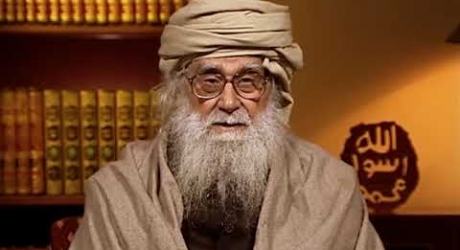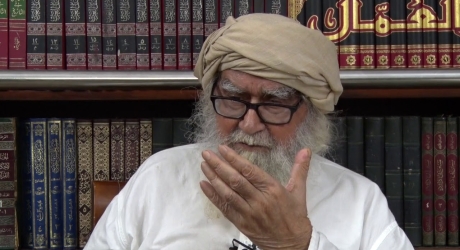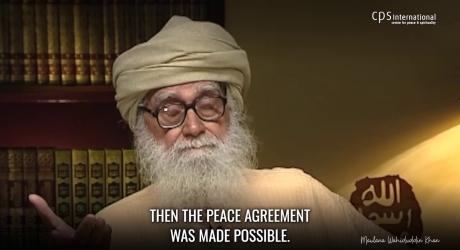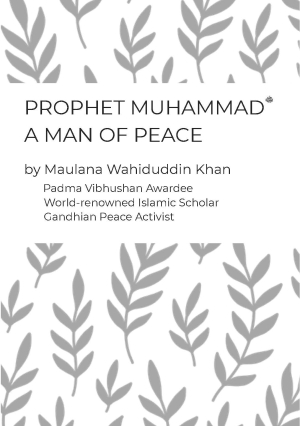The Hudaybiyyah method entailed the greatest of all sacrifices. The Prophet of Islam and his companions decided to make a pilgrimage to Makkah. The Quraysh prevented the Muslims from entering the city, even though they wore the garb of pilgrims and bore no arms. The Prophet of Islam agreed to a treaty between the Quran and the Muslims heavily in favour of the Quran to resolve the tension. He also agreed to return to Medina without completing the pilgrimage and to make the pilgrimage the following year.
What was the remarkable power of the Hudaybiyyah Method that unlocked the doors to a clear victory? Eight years after moving to Medina, the Prophet’s march to Makkah gives us a clue. When the Prophet had undertaken the journey to Makkah two years earlier, he was accompanied by 1,400 companions. This time, however, he was accompanied by 10,000 companions. On the occasion of his first journey, the Makkans forced him to return to Medina; they did not allow him to pass beyond Hudaybiyyah. However, on the occasion of this second journey, the Makkans were so awestruck upon seeing the vast number of the Prophet’s people that they accepted defeat and put up no resistance.
We learn that the Hudaybiyyah Method is the pacifist method of conquering people from this incident. The military option or the violent method causes death and destruction, while the Hudaybiyyah Method conquers people’s hearts. What characterises the method of war is hatred, while what characterises the Hudaybiyyah Method is love.
Albara ibn Aazib, a companion of the Prophet, said to Muslims of later times, “You regard the conquest of Makkah as a victory, but we (the companions of the Prophet) regard Hudaybiyyah. As the real victory.” Ibn Shahaab Zuhri said that the Hudaybiyyah Agreement has the status of a great victory. (As-Seerat an-Nabawiya, Ibn Kathir, Vol. 3, p. 324)
How did the Hudaybiyyah Model pave the way for a victory? What it shows us is that peace is always desirable for its own sake, and every other desirable state comes after peace, not along with it. Once people become tolerant and establish peace for its own sake, what that does is open up opportunities, creating favourable conditions, which enable people to strive for their ideals, eventually attaining justice and other constructive ends.
Featured Articles
Featured Videos
FAQs
Dr. Michael Hart’s well-known book, The 100, was perhaps first introduced to the Muslim world through our Urdu monthly Al-Risala in October 1978. In it, the author selected one hundred of the most distinguished people in history and added accompanying articles about their lives and achievements. He placed the Prophet Muhammad at the top of his list. He wrote that Muhammad was the most supremely successful man in history.
After the publication of this article in Al-Risala, we received many letters from Muslims enquiring about a source from where they could order this book. A number of them even inquired whether an Urdu translation was available. On reading their letters, it was obvious that they were interested only in the supremely successful man, rather than in the secret of his supreme success as well.
What Dr. Hart called a supreme success, the Quran calls a clear victory (48:1). How did the Prophet of Islam achieve this supreme success or clear victory? This verse of the Quran tells us that this extraordinary success was achieved through the Hudaybiyya Peace Treaty. The Quran tells us that the secret of this success lay in the particular method that was employed: the ‘Hudaybiyya Method’.
Let us now consider what the Hudaybiyya Method is. This method entailed the greatest of all sacrifices. The Prophet of Islam, along with his Companions, decided to make a pilgrimage to Makkah. The Quraysh prevented the Muslims from entering the city, even though they wore the garb of pilgrims and bore no arms. To resolve the tension, the Prophet of Islam agreed to a treaty between the Quraysh and the Muslims that was heavily in favour of the Quraysh. He also agreed to return to Medina without completing the pilgrimage and to make the pilgrimage the next year.
Accepting a clearly unfair treaty was a difficult sacrifice to make, but most of the Prophet’s companions returned with him to Medina, on his express insistence.
The Prophet of Islam actually returned from Hudaybiyya without achieving his objective. So when the chapter ‘Victory’ was revealed on his way from Hudaybiyya to Medina, one of the companions remarked, “This is no victory. We were even stopped from entering the House of God.” The Prophet replied, “It is indeed the greatest victory.”
What was the special power of the Hudaybiya Method that unlocked the doors to a clear victory? The Prophet’s march to Makkah eight years after he moved to Medina gives us a clue. When the Prophet had undertaken the journey to Makkah two years earlier, he was accompanied by 1,400 companions. This time, however, he was accompanied by 10,000 companions. On the occasion of his first journey, the Makkans had forced him to return to Medina; they did not allow him to pass beyond Hudaybiya. On the occasion of this second journey, the Makkans were so awestruck upon seeing the huge number of the Prophet’s people that they accepted defeat and put up no resistance.
From this incident we learn that the Hudaybiya Method is the pacifist method of conquering people. The military option or the violent method causes death and destruction, while the Hudaybiya Method conquers the hearts of people. What characterizes the method of war is hatred, while what characterizes the Hudaybiya Method is love.
Source: Spirit of Islam August 2013
The natural formula of peace is based on the principle: Peace for the sake of peace, So, first of all, we have to establish peace and that at any cost. According to this law of nature, peace will certainly open the doors of opportunity and by making the most of those opportunities, you can achieve justice, peace, or any other goal.
This principle was successfully demonstrated by the Prophet of Islam in the form of Sulh al Hudaibiyah or the Treaty of Hudaybiyyah. In fact, Sulh al Hudaibiyah was a peace agreement between Muslims and their opponents. The Prophet of Islam finalised this peace agreement by accepting injustice. At that time the Prophet and his companions wanted to visit Makkah and perform Umrah, but they were prevented from doing so. The Prophet dropped his Umrah plans and finalised the peace agreement by accepting all the conditions laid down unilaterally by the opponents. As a consequence, the companions of the Prophet were very disheartened: they considered it a degrading treaty. One of the companions said at that time, “Why are we accepting such a humiliating agreement?”
However, soon after this peace agreement was finalised, God Almighty revealed this verse in the Quran: “Truly, we have granted you a clear victory.” (The Quran, 48: 1)
Why does the Quran call it a “clear victory” when it was obviously a setback for the Prophet and his companions? This ‘victory’ was in terms of potential victory rather than immediate actual victory. The Sulh al Hudaibiyah agreement stopped all kinds of hostility between the two sides and opened up the doors of opportunity.
After this, it became possible to conduct a dialogue and, have an intellectual exchange, between the two parties. In other words, peace opened the doors for the Prophet to be able to spread his message throughout Arabia.
This prophetic example shows us the way to peace. It tells us how peace can be established and what actions must be taken in such situations of conflict. It is to detach peace from justice. It is to establish peace at any cost. It is to adopt peace for the sake of peace; to re-plan every strategy concentrating on opportunities and not on justice.
Justice is an indirect result of peace and not the direct outcome, so the formula for peace is to establish peace by accepting injustice for a temporary period. Peace will open the doors of opportunity and by availing the opportunities the goal of justice can be reached. The only formula for achieving justice is to accept injustice at the outset; then you will be able to achieve justice in the future by reaping the benefits of peace.
Source: Spirit of Islam February 2013
Whenever a controversy arises between two people or two groups, a practical working arrangement ultimately becomes established. An attempt to change this status quo in most cases results in futility or in all-out strife. What normally happens is that the status quo continues. If not, mutual retaliation results in further losses. In this pointless engagement, precious opportunities are also wasted.
In such a controversial matter, the Prophet’s method was to accept the status quo. The great benefit of this status-quoism is that it gives one the respite to consolidate one’s energies. By removing oneself from the scene of controversy, one may strengthen oneself so greatly that a time will come when ultimately the balance of power will change without any major confrontation.
The Prophet of Islam adopted this wise course on the occasion of the drawing up of the Treaty of Hudaybiya. When the Makkans heard that their opponents had gathered at Hudaybiya, they too reached there to stop the Muslims from going any further. The Prophet at this juncture was on his way to Makkah to perform the rite of Umra (minor pilgrimage). Thus a situation of deadlock came to be created at Hudaybiya. The Prophet did not resort to breaking this deadlock in order to move ahead. Instead, he withdrew and came back to Madinah. It amounted to accepting the status quo already established between the Prophet and the other party. This wisdom gave the Prophet an opportunity for further consolidation, which became a reality within a period of a mere two years. It was at that stage that the Prophet’s victorious entry into Makkah became a possibility.
Source: Spirit of Islam June 2013








